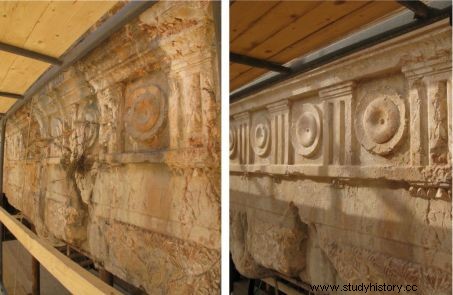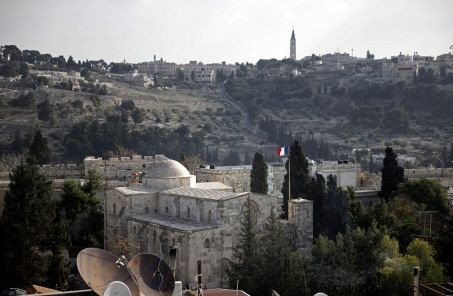Barely reopened to the public on Thursday, June 27, 2019 after ten years of closure due to restoration work, the Tomb of the Kings, in the heart of Jerusalem, closed its doors under pressure from a group of ultra-Orthodox… Back on this exceptional archaeological site, one of the four French domains in Jerusalem.

View of the Tomb of the Kings (Jerusalem) during restorations.
It is a remarkable monument that risks remaining inaccessible for a long time. Located on a plot of 0.2 hectares 700 meters north of the Old City of Jerusalem, in the Palestinian neighborhood of Sheikh Jarrah (sector occupied by Israel since 1967 under international law), this tomb is indeed the for years of pressure from some religious. This is why the French authorities - to whom the site belongs - had already embarked on a waltz-hesitation of several months to set the date for its reopening to the public after ten years of restoration. This finally took place on Thursday, June 27. But when a small group of about 15 people with reservations had just entered it, scuffles broke out, caused by a gathering of ultra-Orthodox Jews at the entrance to the site, forcing the authorities to interrupt sine die the rest of the scheduled visits.
If the tricolor flag flies above this area, it is because it has been part - like three other places located in and around Jerusalem - of French domains since the end of the 19th century. Hypogeum of the biblical kings David and Solomon for some, last resting place of an ancient Jewish family for others, this site has fueled passions since its discovery by Europeans in the 19th century. It is to the French Félix de Saucy (1807-1880) that we owe the first elements of this monument to have been revealed... who planted the seeds of a controversy as to its attribution.

Detail of the lintel of the Tomb of the Kings before and after restoration. Credits:Consulate General of France in Jerusalem
During the excavations he directed in 1863, Félix de Saulcy, who was also an epigraphist, discovered a room in which a sarcophagus bearing a double inscription in Aramaic mentions the name of Sadane. A hitherto unknown queen. From the outset, the researcher considers that it is a Jewish queen not mentioned in the Bible, a sister of David, while René de Chateaubriand, visiting Jerusalem, recognizes in this funerary monument a Greek architecture. For the French writer and politician, there is no doubt that this tomb dates from classical antiquity, in the 1 st century of our era. Other prominent archaeologists, including Ernest Renan, believe that Sadane refers to a queen of Adiabene, a kingdom located at the site of present-day Iraqi Kurdistan. “Texts mentioned that the royal family of Adiabene had converted to Judaism in the middle of the 1 st century of our era ", explains Jean-Sylvain Caillou, archaeologist associated with the French Institute of the Near East (Ifpo), in charge of the study of the site, restored by ACMH Michel Goutal under the aegis of the French consulate. The Roman historiographer Flavius Josephus (38-100) also tells how the queen mother, Helen of Adiabene, had settled in Jerusalem after having built three palaces for her and her relatives, as well as an important burial north of the city. “The discovery of the sarcophagus with the inscriptions in Eastern Aramaic therefore refers us to this family », continues Jean-Sylvain Caillou. But there you have it… There has also been a communal – rather than a religious – interpretation of this place since the mid-19th century, long before the site was archaeologically surveyed. In the eyes of some Jews, this tomb is attributed to a certain Kalba Shavua, considered a holy man. An interpretation that suddenly came to "rub" against that of archaeologists. "In reality, as early as 1863, everyone knew that this tomb was linked to this queen of Adiabene, even if there were supporters of an alternative theory “says Jean-Sylvain Caillou.
"Archaeological excavations undertaken in 2007 by Father Jean-Baptiste Humbert of the Ecole Biblique de Jerusalem, then the discovery of coins dated 54 CE confirmed the dating of the mausoleum and its unmistakable belonging to the 1 st century of our era and to this family of Adiabene “, continues the archaeologist. Which also indicates that the tomb has, at different phases, known pagan reuses after its royal use. Roman soldiers, for example, used it to bury their dead there. “Then, after the 4th century, this place fell into oblivion , continues the archaeologist. What is interesting is that this Tomb of the Kings is in fact the very first modern archaeological site in the Near East:once given to France in the 19th century, it was immediately opened to the public. And that long before Baalbek in Lebanon [the ancient Heliopolis of the Romans Ed]!” The monument indeed became the property of France after the Pereire brothers, French industrialists of Jewish origin, acquired it in 1878 to offer it to the Republic in 1886.
However, the Tomb of the Kings is not the only property of France in Jerusalem, the only foreign power to own a few acres there making up four "national domains". "This monument and the Basilica of the Eleona, on the Mount of Olives, were offered to France by private owners , explains Jean Bellier, Attaché for Real Estate Affairs at the French Consulate in Jerusalem. What is to be distinguished from the two other national domains, the Romanesque churches built by the Crusaders:Ste Anne, in the old town and Abou Gosh, outside, offered to France by Napoleon III by the Ottoman Empire , in thanks for his support during the Crimean War against Russia (1854-1856) .
The four estates, of high archaeological and historical value, are a major heritage that France maintains and restores so that the public has access to them. Closed for ten years for renovations, the reopening of the now-restored historic site that is the Tomb of the Kings will still have to wait...

Saint Anne's Church, in the Old City of Jerusalem. Credits:Thomas Coex /AFP
Saint Anne:(East Jerusalem)
Total area:0.6 ha
Date acquired: 1856
This church would have been built on the place where Mary (the mother of Christ) would have lived. Around the church, there is a major archaeological site, since it is the location of the probationary pools which supplied water to the temple of Jerusalem, at the time of the Second Temple (1 st century CE). The church where Christian tradition places the miracle of healing of a paralytic by Jesus. Begun in 1856, the first restoration work and archaeological excavations were carried out by the architect C. Mauss. The sanctuary will then be entrusted in 1878 to the White Fathers of the Society of Missionaries of Africa, founded by Cardinal de Lavigerie. Today occupied by about 25 of these members, the Estate is managed in close collaboration with the Consulate General of France in Jerusalem.
The Eleona
Area:0.3ha, in addition to a 1.3ha olive garden belonging to the White Fathers, all open to the public.
Date of acquisition:1874
Also known as the Pater Noster , this is the 4 th national domain, located at the top of the Mount of Olives. Having developed a passion for this site in 1856, Princess Héloïse de la Tour d'Auvergne spent the light of her fortune and her time buying this estate, plot by plot, from the local owners of the time, to make build a monastery on the ruins of a Byzantine church destroyed and abandoned after the Persian invasion. The Crusaders had rebuilt a small chapel there. To perpetuate her project and make it a holy place, the Princess of the Tour d'Auvergne donated it to France. This bequest thus includes the cave and the place of the ancient Byzantine basilica; an olive garden at the White Fathers; a large piece of land where she erected a monastery, bequeathed to the order of Carmel.
Abu Gosh :
Area:1.8 ha
Date of acquisition:1873 (gift from the Ottoman Empire to France).
Located outside Jerusalem, unlike the three other sites of the French domains located in the eastern districts of the city, this site is located in the heart of the Arab village of Abu Gosh, in Israel (between Jerusalem and Tel Aviv). A Romanesque church built by the Crusaders now houses a monastery in which 15 nuns and 8 monks live on site (a Benedictine monastic community of Olivetan tradition). (Site not to be confused with another religious building located at the top of the hill of Abou Gosh, currently under study (read Sciences and Future n° 863 ).
